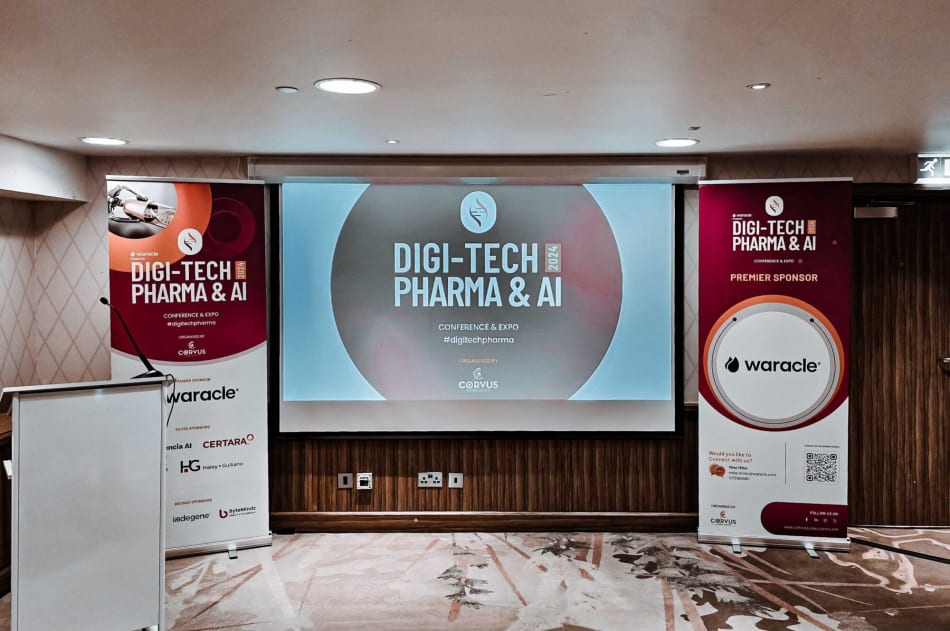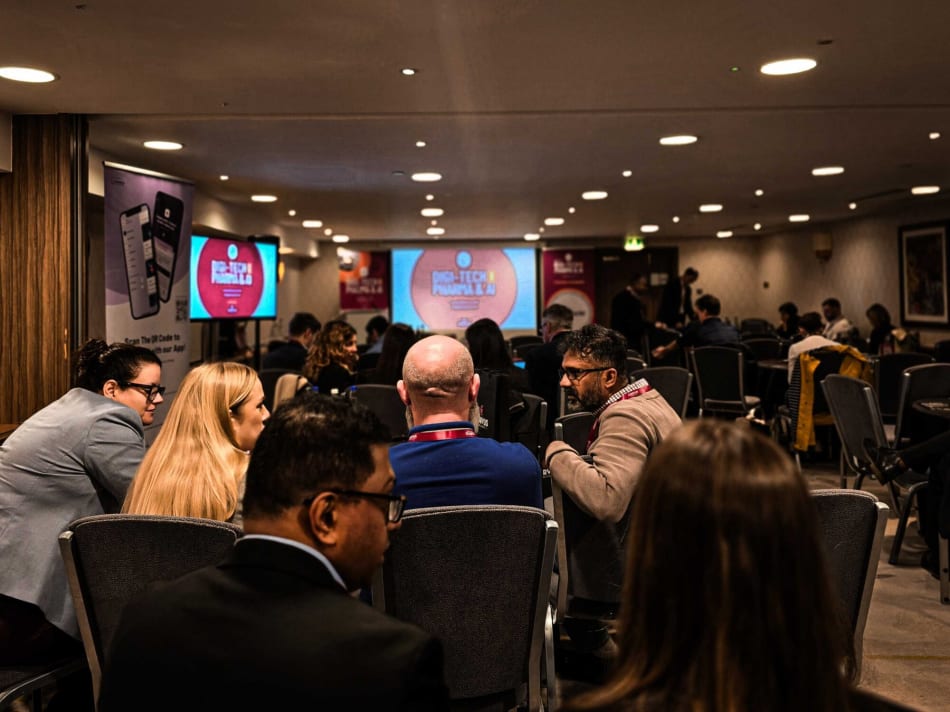
Waracle was the proud premier sponsor of the 7th annual Digi-Tech Pharma & AI 2024 conference and expo held at the London Hilton Kensington on the 28th and 29th of May.
The conference brings together experts and thought leaders across the industry to explore the conference’s theme of ‘The emergence of Digital Technologies in the Pharmaceutical Industry’.
It was a fantastic event focused on the application of AI to deliver real-world value for patients and businesses. Bruce Hellman set the tone right from the off on day 1, telling us that the “pendulum has swung” in the industry from ‘talking about the tech’ to ‘talking about the business value’.
It was clear from listening to all of the fantastic speakers that we are undergoing a digital healthcare revolution. Digital technology, data, and artificial intelligence are being used to solve some long-standing industry challenges and provide a path to a future that promises accelerated innovations and a shortening of the timeframe to meet patients’ needs. We are in the age of personalised health and the rise of the healthcare consumer.
Here are our top 7 top themes and takeaways from the event:
1. AI for clinical documentation automation
AI and Gen AI were central topics for the conference. While many use cases were discussed, the one with the most evidence of tangible ROI was the automation of documentation processing and generation.
The real value of using AI / Gen AI to vastly reduce costs and increase speed in producing regulatory and clinical documentation was highlighted by several talks. Novo Nordisk (Louise Lind Skov and Waheed Jowiya) outlined the compelling ROI they have achieved with their Novoscribe system that reduced the time to produce clinical study reports from 90 days to a week, and the number of people needed for this process from 42 to just 3, all with a reduction in error rates.
Marcos Camara of Astellas Pharma Europe also touched on this in his talk, highlighting the high cost of content creation across areas such as scientific output, medical information requests, and product information and the role that AI and intelligent agents play in streamlining many of these processes.
Key takeaway:
Gen AI’s power to understand, summarise, and generate clinical & medical content and reports is proven to improve speed and quality. This is a very accessible use of Gen AI with a clear ROI and one that all Pharma should be looking at.

2. AI in drug discovery, development and personalised health
Hassan Abba at AstraZeneca talked about the company’s approach to using AI to develop new molecules and get therapies to patients faster. The company has compressed the timeframe for candidate drugs using AI from 3 years to 1 year.
We heard about the potential for AI in drug repurposing from Paul Agapow at GSK. This is still in the experimentation phase, but there is potential for AI to enable systematic drug repurposing at scale, which could effectively shortcut the process and vastly reduce the time needed to offer treatment to patients.
Jakob E. Larsen discussed AI in target discovery and outlined the success Novo Nordisk has had in using AI to compress the R&D funnel by accelerating and scaling target discovery. Jakob talked of the importance of identifying unmet needs, improving outcomes, and reaching more patients as a north star for innovation and how Novo Nordisk has targeted these in the areas of diabetes, obesity, cardiovascular, and rare diseases. Julio Molineros also covered using AI and network models in drug discovery and development at Johnson & Johnson.
Claudia Wiedemann at Evinova (part of AstraZeneca) gave an overview of how they use AI to set up and manage clinical trials in areas like data and statistical analysis, validation, pipeline management and patient recruitment, study milestone predictors, and workflow automation.
Guillaume Desachy gave a great talk on prognostic and predictive digital biomarkers and the application of AI in precision medicine, drawing on his experiences at Pierre Fabre. Andrew Buchanan at AZ followed this up and looked at AI/ML for Biologics and the positive impact this has had on lead identification and optimisation. Novartis similarly uses AI to personalise cancer patient care treatment, as explained by Rafik Fellague-Chebra.
Key takeaway:
With the correct data, AI has tremendous power in drug discovery, either in accelerating the repurposing of existing drugs for new conditions, accelerating the top of the R&D funnel, tailoring precision medicine, or improving the planning and execution of clinical trials.
3. Practical steps for using Gen AI
Nick Brown at Certara – Nick talked about the practical difficulties in managing larger Gen AI models securely and sustainably, that using RAG architecture can help address hallucinations, and that there is a move to smaller, more specialised models. Studies have shown that using a RAG architecture with smaller models can achieve a similar level of quality as larger models (pinecone.io study). Nick also talked about how a prompt library can improve consistency in how people use models across an organisation.
GenAI has weaknesses and limitations, particularly around privacy and security, and it is essential to have the right architectural processes and guardrails to control and mitigate these.
Marcos Camara at Astellas Pharma Europe gave great insights into Gen AI adoption strategies and challenges. Marcos explained the challenges of data quality and silos, strategies to overcome these, and how intelligent agents can support data analysis, content creation, and summarisation. Marcos presented a template for AI maturity assessment and adoption, outlining key areas on this journey, such as defining a strategy, legal consideration, understanding ROI, tackling data and integration challenges, and making the correct buy vs. build decisions.
Ritesh Dogra at Indegene continued on this theme, discussing how we can cut through the hype to understand the reality of the opportunity with Gen AI and provided a helpful ROI framework for assessing use cases.
Gary Crawford outlined Gen AI’s core capabilities as the human-like ability to listen, reason, and communicate. We can use these capabilities independently or in combination to achieve massive improvements in customer experience, even if the model output is not directly in front of a user or patient due to safety concerns.
Key takeaway:
The journey to success with AI / Gen AI is not straightforward, and there are many hurdles to overcome, including data quality and silos, security and safety of models, hallucinations, and adoption considerations across people, organisational and technology dimensions.
However, we can overcome these risks with the right strategy, architectures, and guardrails to deliver lasting change and business value.

4. Mobile apps, sensors and digital biomarkers for personalised healthcare
Several of the conference’s key focus areas were patent-centric solutions, real-world data, and the need to scale and improve the success of clinical trials. These all point to the decisive role that mobile and wearable technology and associated biometric data can play here.
Irena Brookes-Smith from AstraZeneca posed the question, “Is the clinical trial process broken?” highlighting failure and dropout rates, enormous costs ($1.5-2Bn to bring a new drug to market), and long timeframes (8-10 years from phase 1 to approval).
Claudia Wiedemann of Evinova built on this with the eye-opening statistic that 35% of patients drop out due to a lack of patient-centric design and that greater than 75% of patients are interested in telehealth and remote monitoring. Claudia explained how AI and digital tools can provide benefits such as remote patient monitoring and near real-time analytics that can help significantly reduce these dropout rates.
Andy Cacholdora discussed the use and benefits of wearables and smart devices in disease monitoring and management and the use of this data alongside AI to support early diagnosis and treatment.
This was also in line with the success stories shared by Gary Crawford of Waracle’s work to digitise clinical trials using mobile devices and apps across several therapeutic areas and conditions such as diabetes, multiple sclerosis, and Parkinson’s disease. Gary talked of moving “beyond the molecule”, moving past the observation of the usual biomarkers and molecular data, and embracing the full spectrum of holistic health – from genetics to lifestyle.
Spencer Jones gave a great talk on Digital Therapeutics (DTx), a growing area with vast potential to improve healthcare driven by technological advancements, government initiatives, and a need to combat escalating healthcare costs in general. There are many real-world examples of digital solutions improving patient outcomes, and the right combination of digital technology, AI, and behavioural science can drive engagement and motivation.
Key takeaway:
Mobile technology’s power as a pervasive and patient-centric technology is growing, and it has the potential to scale healthcare and improve patient outcomes across therapeutic areas.
5. The importance and challenges of data, real-world data (RWD) and FAIR data principles
The importance of data in any AI project was a common theme, with the need for high-quality curated and refined data key to success. The FAIR data principles (findability, accessibility, interoperability, and reusability) are designed to optimise data reuse, and Jimmy Toulas outlined these as a critical component of Pfizer’s success.
A major industry challenge is the ability to combine different data sets and create a unified data model. The Edhen project is an example of a collaborative effort between big pharma companies to build a federated data platform with a standardised data model.
Hassan Abba from AstraZeneca talked about the importance of data for both Gen AI and Machine Learning. There is a data iceberg that lies underneath creating effective business outcomes from AI, and this is about connecting disparate data in a meaningful way, leveraging ontologies, shared vocabularies, and effective master and reference data management. The improvement of data quality at the source is critical and is driven by the right IT and data strategy.
Hassan Khalid built on this by extolling the benefits of data integration as a catalyst for innovation, how an FCNN-based approach to Multiomics data integration can be used, and how to define data products and bring these together with multidisciplinary data and engineering teams. James Duboff also covered multiomics integration in detail, highlighting the successful approaches in diagnosing disease and driving drug development in the 100,000 Genomes project.
Irena Brookes-Smith (AstraZeneca) opened day 2 with a fantastic talk outlining how real-world data can help bring clinical trials closer to clinical practice. The reality of clinical trials taking 800 days to start and 80% failing to meet their deadlines shows the real bottlenecks in bringing new medicine to patients. Andy Cacholdora at GE Health also covered this in his talk, explaining how Connected Data and Single Patient Jackets can support precision health through integrated patient data.
Using RWD and RWE can have huge benefits. Its growing use is being driven by the fact it is already available and recorded by clinicians, physicians, and doctors; it is growing in acceptance by regulators, and the adoption of standards and access to open data sources such as CPRD in the UK is helping to remove impediments to its use. AZ has had great success using RWE to inform critical decisions such as trial design and understanding of the target population.
Key takeaway:
Data and AI go hand in hand, and alongside the growth in AI capabilities, we are seeing a similar revolution in the focus, use, and availability of data. Real-world data (and, by extension, Real-World Evidence and Insights) can significantly accelerate and improve patient outcomes across clinical trials and beyond.

6. Partnerships to accelerate innovation
In an industry undergoing rapid change driven by new technologies, successful partnerships are critical to accelerating innovation and delivering positive patient outcomes.
We heard about many successful partnerships between larger Pharmaceutical organisations, startups, industry incubators, and innovation hubs. Konrad Dobschuetz made this point well and explained the importance of a good governance structure around any partnership. We also heard a real-world example of the productive partnership between Sandoz (Dan Ma) and Temedica (Benjamin Friedrich), lessons learned, and tips for success.
The idea of an industry-wide collaboration on areas such as data was a topic of interest, and Guillaume Desachy at Pierre Fabre raised the possibility of a consortium to share clinical trial participants.
Daniyal Hussain discussed how GSK has used strategic partnerships to develop data and platform technology. He said that when evaluating partners, it’s important to consider scientific credibility, the importance of use cases for the technology, the availability of validating data, talent, and the right risk/reward structure in the deal.
Daniyal also gave some great advice on making partnerships successful: don’t overcomplicate, consider the viewpoints of many stakeholders, anticipate change, be honest, and don’t overpromise.
Key takeaway:
Partnerships can be an innovation accelerator, and many larger Pharmaceutical companies are looking at adding new complementary capabilities through partnerships with innovative startups and industry innovation incubators. The key to getting the most value from a partnership is to build trust, shared objectives, and a strategy to maximise each partner’s relative strengths.
7. Pay attention to the people side of AI transformation
We heard about many real-world examples of transformation and successful applications of AI, and the importance of the people and organisational side of any change programme underpinned all of these.
Many speakers stressed the importance of the people-side of change. The use of AI requires new ways of working and a change management process that involves everyone. This needs to be both a top-down and bottom-up endeavour.
The cultural aspect of AI adoption is essential. Marcos Camara at Astellas Pharma Europe discussed the need to develop a tech-driven culture to ease the introduction of emerging technology.
Novo Nordisk discussed the change in team setup under their new AI-driven clinical documentation process. Andrew Buchanan spoke of the importance of multidisciplinary teams coming together. Hassan Abba gave a great illustration of how a scientist’s “day in the life” changes with AI.
During the conference, many speakers mentioned an agile approach to change. Anastassia Anastassopoulou talked about adopting agile principles at Daiichi Sankyo Europe GmbH to enable digital change and enhance innovation. Marina Borozna at Ipsen followed this up with a great set of learning from 100+ projects, highlighting the importance of focusing on an integrated solution of human and machine and the importance of an agile mindset to manage both scepticism and hype.
Key takeaway:
People and processes are as significant an element of AI transformation as the technology itself. Careful attention to ensure these aspects are planned into the change management process and that people are taken along on the journey can make or break success.

Conclusion
After an amazing two days packed with brilliant speakers, the fantastic innovations presented clearly show that the pendulum has genuinely swung. The industry is building a solid momentum of business and patient value delivery, leveraging the latest advancements in digital, data, and AI technologies across clinical processes and therapeutic areas.
We are in an age of transformation, and it is clear that people and partnerships play as big a role as the technology itself. We are just scratching the surface of AI’s potential. While there are still questions to answer in areas such as security, ethics, and safety and a data problem to solve, the potential benefits for health businesses and patients are unquestionable.
Why Waracle?
Waracle designs and engineers intelligent digital experiences in health across diagnostics and therapeutics. We’re a strategic partner that provides access to expert capability and scalable capacity, helping our clients in Pharma, Biotech, and Healthtech accelerate the delivery of secure and inclusive digital products, services, and experiences.
To learn more about our thinking and work in AI, download our Gen AI eBook.

Authors
Client Partner
Managing Director
Scrum Master
Technical Project Manager
Client Partner
Related

Article • 09 December 2025
From sandbox to squad: AI-enhanced delivery in practice

Article • 05 December 2025
The art of applying stoicism to sales craft

Article • 26 November 2025
Why data infrastructure delivers value regardless of market direction

Article • 24 November 2025
Waracle accelerates growth with acquisition of Sofia-based Hacksoft

Article • 14 November 2025
Waracle secures long-term digital transformation deal with People’s Partnership





